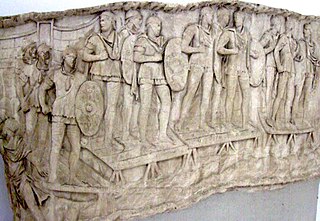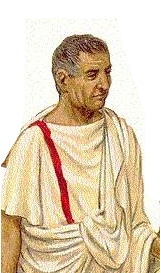
The Praetorian Guard was an elite unit of the Imperial Roman army that served as personal bodyguards and intelligence agents for the Roman emperors. During the Roman Republic, the Praetorian Guards were escorts for high-ranking political officials and were bodyguards for the senior officers of the Roman legions. In 27 BC, after Rome's transition from republic to empire, the first emperor of Rome, Augustus, designated the Praetorians as his personal security escort. For three centuries, the guards of the Roman emperor were also known for their palace intrigues, by whose influence upon imperial politics the Praetorians could overthrow an emperor and then proclaim his successor as the new caesar of Rome. In AD 312, Constantine the Great disbanded the cohortes praetoriae and destroyed their barracks at the Castra Praetoria.
The equites constituted the second of the property-based classes of ancient Rome, ranking below the senatorial class. A member of the equestrian order was known as an eques.
A military tribune was an officer of the Roman army who ranked below the legate and above the centurion. Young men of Equestrian rank often served as military tribune as a stepping stone to the Senate. The tribunus militum should not be confused with the elected political office of tribune of the people (tribunus plebis) nor with that of tribunus militum consulari potestate.

Praefectus, often with a further qualification, was the formal title of many, fairly low to high-ranking, military or civil officials in the Roman Empire, whose authority was not embodied in their person but conferred by delegation from a higher authority. They did have some authority in their prefecture such as controlling prisons and in civil administration.

The primus pilus or primipilus was the senior centurion of the first cohort in a Roman legion, a formation of five double-strength centuries of 160 men, was called the primus pilus; he was a career soldier and advisor to the legate. The Primus Pilus would remain in command for one year. They could continue to serve in the army after their term ended if there was a vacancy in command or if they wished to become an independent commander of an auxilia unit or the praefectus castrorum.

The Auxilia were introduced as non-citizen troops attached to the citizen legions by Augustus after his reorganisation of the Imperial Roman army from 27 BC. By the 2nd century, the Auxilia contained the same number of infantry as the legions and, in addition, provided almost all of the Roman army's cavalry and more specialised troops. The auxilia thus represented three-fifths of Rome's regular land forces at that time. Like their legionary counterparts, auxiliary recruits were mostly volunteers, not conscripts.
A decurion was a Roman cavalry officer in command of a squadron (turma) of cavalrymen in the Roman army.
A turma, was a cavalry unit in the Roman army of the Republic and Empire. In the Byzantine Empire, it became applied to the larger, regiment-sized military-administrative divisions of a thema. The word is often translated as "squadron" but so is the term ala, a unit that was made up of several turmae.

The equites singulares Augusti were the cavalry arm of the Praetorian Guard during the Principate period of imperial Rome. Based in Rome, they escorted the Roman emperor whenever he left the city on a campaign or on tours of the provinces. The equites singulares Augusti were a highly trained unit dedicated to protecting the emperor. Men who served in the equites singulares Augusti held a Roman public status as equites.

A tribunus angusticlavius was a senior military officer in the Roman legions during the late Roman Republic and the Principate.

The Imperial Roman army was the military land force of the Roman Empire from 27 BC to 476 AD, and the final incarnation in the long history of the Roman army. This period is sometimes split into the Principate and the Dominate (284–476) periods.
Traianus Mucianus was a Roman soldier of Thracian origins of the second half of the Third Century AD who rose from the lowest ranks of the army to senior commands. He was almost certainly a remarkable soldier. However, the successive promotions he secured in the latter part of his career are thought to owe much also to the favour shown him by men highly placed in the Imperial entourage whose patronage secured him advantageous postings in the Imperial comitatus, the mobile field force under the direct command of the Emperor, that was undergoing massive expansion at this time.

Gaius Caristanius Fronto was a Roman soldier and equites whom Vespasian promoted to the Roman Senate for his loyalty to the latter in the Year of Four Emperors. He was appointed suffect consul in AD 90 as the colleague of Quintus Accaeus Rufus.

Marcus Macrinius Avitus Catonius Vindex was a Roman senator who was active during the reign of Marcus Aurelius. Originally a member of the equestrian order, Vindex demonstrated courage and intelligence that led to his award of dona militaria and elevation into the Senate, followed by his appointment to the consulate, which Géza Alföldy dates to an undetermined nundinium around the year 175.
Gaius Minicius Italus was a Roman eques who flourished during the reign of the emperors Vespasian, Domitian, and Trajan. He was appointed to a series of imperial offices, both military and civil, culminating with praefectus or governor of Roman Egypt.
Quintus Caecilius Redditus was a Roman eques who held a number of appointments during the reigns of the Emperors Trajan and Hadrian. He is known in a series of inscriptions.
Titus Furius Victorinus was a Roman eques who held a number of appointments during the reigns of the Emperors Antoninus Pius and Marcus Aurelius. The most prominent of these offices were praefectus vigilum, praefectus or governor of Roman Egypt, and praetorian prefect.
Marcus Petronius Honoratus was a Roman eques who held a number of military and civilian positions during the reigns of the Emperors Hadrian and Antoninus Pius, which included praefectus annonae and praefectus or governor of Roman Egypt.
Quintus Marcius Dioga was a Roman eques who flourished during the reign of the emperor Septimius Severus and his sons. He was appointed to a series of imperial offices, including praefectus annonae,, and praefectus vigilum.








